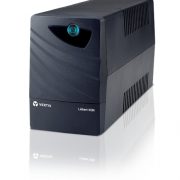UPS Repair Singapore
Have a faulty UPS that needs a repair?
Throughout the numerous UPS repair we have done, we are often asked what are the faults that could have happened to our customer’s UPS. To facilitate the UPS repair process and explain the inner workings of a UPS, we have come up with a brief introduction to the UPS for the benefit of our customers.
Let us first understand what is a UPS :
A UPS (uninterruptible power supply) as its name suggest, aims to provides uninterrupted power supply to equipment connected to it through the use of electronics and batteries.
The UPS comes in various sizes, mainly:
1. Desktop size – this form factor usually provides around 600VA of power (more will be explained about what is VA)
Vertiv Liebert ItON 600VA Line-Interactive 360 W 2 AC outlet(s)
2. Rack mountable – This form factor usually provides between 1500VA to 3000VA of power and has extendable battery cabinets to provide twice or more backup time.
3. Tower size – this form factor usually provides more than 6000VA of power and installing this kind of UPS requires professionals
How does a UPS work?
An uninterruptible power supply (UPS) provides backup power when the main power source is interrupted (power trip) or when the mains input voltage drops to an level that is below specification (for instance 230v ac). It does this by constantly charging the batteries that are inside the UPS when the mains are working, and draws power from the batteries when the mains fail. The UPS will also allows for a computer or equipment to shutdown prior to running out of battery through the use of USB cables and software.
There are a few kinds of UPS design that is available in the market. Namely, standby, line interactive and double-conversion (online)
Standby is the most basic UPS topology. A standby UPS changes to use battery backup power in the event of mains power problems such as a power trip, a drop in voltage, or sudden voltage increase. in these situation, the UPS switches to DC battery power and then inverts it to AC power to run connected equipment. These models are designed for consumer electronics, entry-level computers, POS systems, security systems, and other basic electronic equipment. The disadvantage to this approach is that there is a slight delay or power fluctuations between changing power source from mains to the battery and sensitive equipment might not work properly as a result of this delay.
A line interactive UPS has mechanisms which allows it to correct minor power fluctuations (under-voltages and over voltages) without switching to battery. It has a power line conditioner built in. This type of UPS has an autotransformer that regulates low voltages (e.g., brownouts) and over voltages (e.g., swells) without having to switch to battery. Line interactive UPS models are typically used for consumer electronics, PCs, gaming systems, home theatre systems, corporate network equipment, and entry-to-mid-range servers. They provide power during such events as a blackout, voltage sag, voltage surge, or over-voltage.
A double-conversion (online) UPS provides consistent, clean, and near perfect power regardless of the condition of incoming power. This UPS converts incoming AC power to DC, and then back to AC. UPS systems with double-conversion always outputs power based on isolated DC power such that it has zero transfer time because there is no delay in switching (since its always output power based on DC). Double-conversion UPS systems are designed to protect mission-critical IT equipment, data center installations, high-end servers, large telecom installations and storage applications, and advanced network equipment from damage caused by a power blackout, voltage sag, voltage surge, over voltage, voltage spike, frequency noise, frequency variation, or harmonic distortion. The downside to this approach is that efficiency might be lower than a UPS that uses bypass power and switches to DC when mains fail. UPS normally has a indicated power factor rating of between 0.9 (90% efficient) and 1 (100% efficient).
The Components of a UPS

Components of a UPS
A. Lead Acid Batteries
UPS batteries
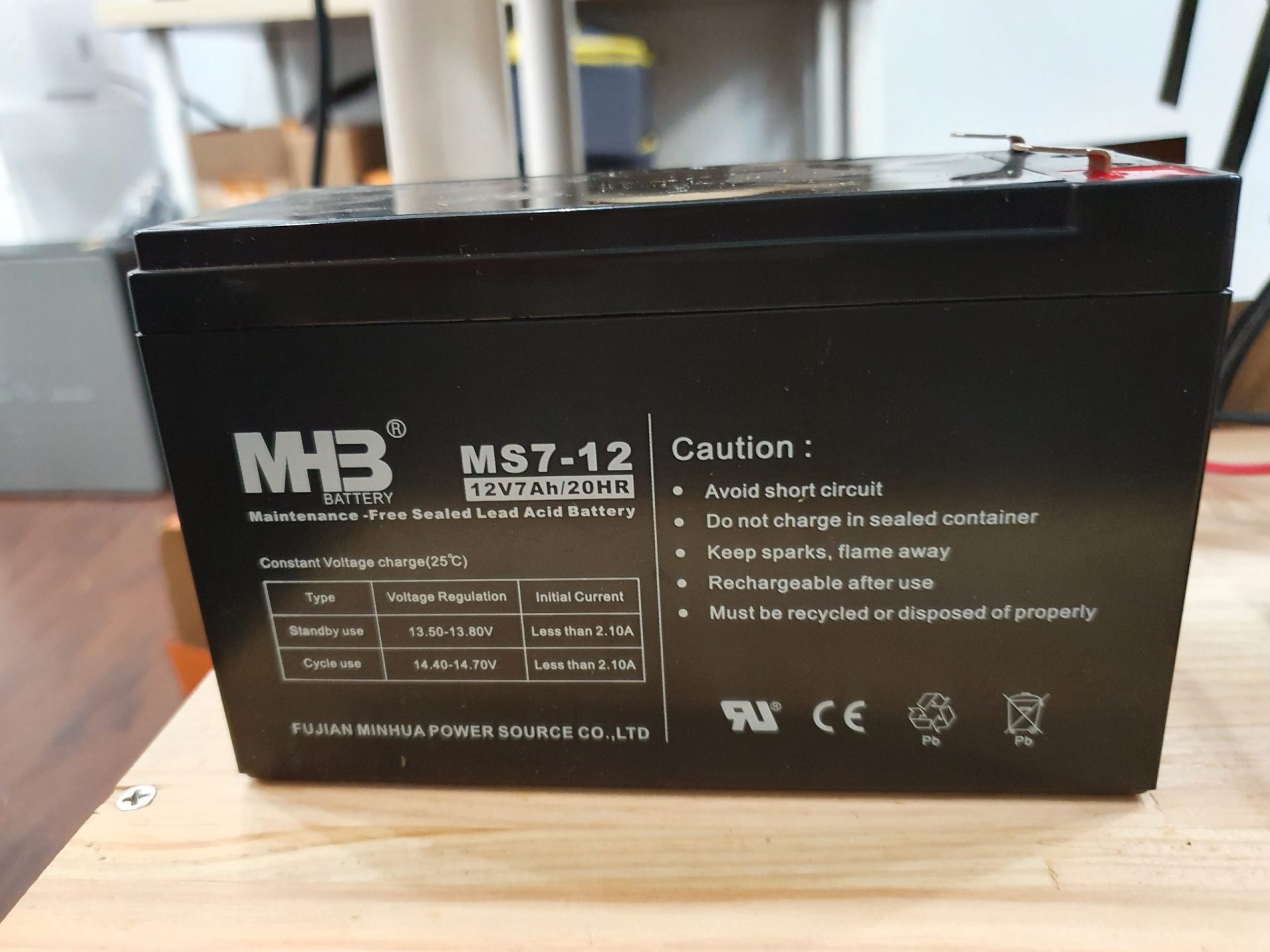
UPS Battery
The batteries inside UPS are generally of the Lead Acid Battery (Absorbent Glass Mat (AGM)) maintenance free type. They normally operate at 12v DC voltage.
While regular lead acid batteries need a topping charge every six months to prevent the buildup of sulfation, AGM batteries are less prone to sulfation and can sit in storage for longer before a charge becomes necessary. The battery stands up well to low temperatures and has a low self-discharge. Due to the low level of fluid inside the battery, the positioning of the battery does not affect its operations.
The leading advantages of AGM are a charge that is up to five times faster than the flooded version, and the ability to deep cycle. AGM offers a depth-of-discharge of 80 percent; the flooded, on the other hand, is specified at 50 percent DoD to attain the same cycle life. The negatives are slightly lower specific energy and higher manufacturing costs than the flooded, but cheaper than the gel battery.
The battery however are still vulnerable to gas build up and might bloat and have cracked casings issue if the batteries are not properly used (constant float charge) during its operational life cycle.
The batteries generally uses F1 (T1) or F2 (T2) terminals.
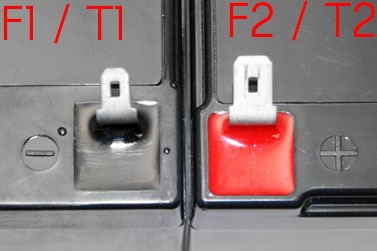
UPS Battery Terminals
B. Transformer
The transformer converts wall voltage (240vac) into voltage levels that are manageable by the circuits inside the UPS. As the lead acid batteries are 12vdc (or typically 72vdc for higher capacity UPS), the voltage must be stepped down and then rectified (converted into DC) in order to charge the batteries. The reverse is true when the input mains) is down and the batteries must be used to “step up” the voltage back to 240vac to supply power to the equipment that are attached to the UPS.
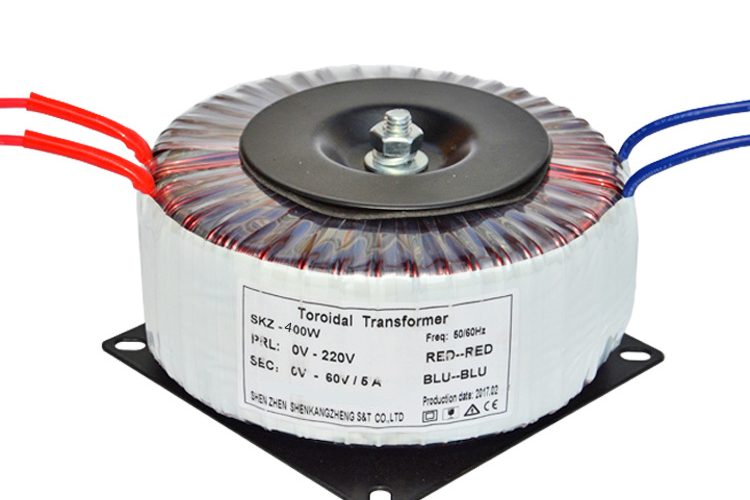
transformer coil
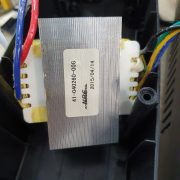
transformer
Transformers convert AC electricity from one voltage to another voltage, usually with little loss of power.The input coil on a transformer is called the primary and the output coil on a transformer is called the secondary. Transformers are passive devices, they do not fail easily unless the insulating materials between the slabs fails. Transformers replacement statistically forms less than 1% of our UPS repairs.
With reference to the same principle, laptop power supply adaptors also converts 240v ac (mains) into DC power that are manageable by the laptop’s mainboard. Typically 19.5 vdc. Most of the laptop repair we performed on the laptops mainboards are due to faulty power supply adaptors that supplied either too high or too low voltages that induces excessive stresses on the laptop mainboard circuits. Using good quality adaptors will reduce the likelihood of having a laptop mainboard failure caused by bad quality adaptors.
C. Fuses
The fuse breaks the circuit if a fault in an appliance causes too much current to flow (for instance in a short circuit condition). This protects the wiring and the appliance if something breaks. Inside the fuse there is a piece of wire that melts easily. If the current going through the fuse is too high, the wire will heats up till the point where it melts and breaks, thereby cutting the connection in the circuit.

Glass fuse with visible wire
D. UPS Control circuit
This is the part of UPS that monitors battery charge level, UPS load level, and alarm functions.
E. Voltage Regulators and Rectifying Circuit
The battery in UPS that gets charged by power from the AC mains, however directly applying the AC mains to the battery will destroy it. The transformer does the job of stepping down the 240v AC to 72vAC (in a high capacity UPS) however the batteries need to be charged at 74v DC. The rectifying circuit will convert the Alternating current into Direct Current. As with all mains, there will be fluctuating outputs (voltage fluctuation may occur due to condition of the power grid, other appliances turning off and on, time of day, environmental factors, etc.) that jump from ±2V can cause inefficient operation and possibly even damage to the batteries. Therefore the voltage regulators comes into the picture to provide a steady constant voltage.
F. SNMP Module
The slot provides for an optional SNMP module that allows the UPS to communicate on the LAN network.
Simple Network Management Protocol (SNMP) is an application–layer protocol defined by the Internet Architecture Board (IAB) in RFC1157 for exchanging management information between network devices. It is a part of Transmission Control Protocol⁄Internet Protocol (TCP⁄IP) protocol suite.
SNMP is one of the widely accepted network protocols to manage and monitor network elements. Most of the professional–grade network elements come with bundled SNMP agent. These agents have to be enabled and configured to communicate with the network monitoring tools or network management system (NMS).
G. Relays
A relay is a switch that is controlled electrically in order to control the high power/current/voltage circuits with its low-voltage circuit signal. This allows the low-voltage circuit to maintaining complete electrical isolation between the high voltage and the low voltage side.
Common Faults observed on UPS
1. Batteries – The Lead Acid batteries inside the UPS does not last forever. They are built to last for 5 years typically and they must be constantly charged to maintain operational. A common issue we see with UPS fault is that they are left in storage and when the users want to use them again, they are unable to work. A fully charged UPS batteries can be kept in storage for maximum of 6 months before they start to lose their capacity permanently.
2. Blown Fuses – The UPS are subjected to high surges when the mains goes off and back on. This is due to the power drawn by the attached equipment. When the mains surge, or when the equipment draws too much current, the fuse will blow thereby rendering the UPS unusable.
3. Capacitors – They stores and releases electrical energy to smoother out fluctuating voltages. The electrolyte based capacitors generally needs to be replaced every 5 to 7 years.
The UPS typically contains a dozen or more capacitors, which are responsible for smoothing out and filtering voltage fluctuations.
4. Fans – The Fan is actually a critical component of the UPS as it lowers the temperature of the voltage regulators. Without the fan, the voltage regulator will burn out fairly quickly. These Fans do not last forever as most of them are bearing based and due to friction, the brushes wears out.
We are expert in UPS repair. If you have any issues with your UPS, please do not hesitate to contact us!

